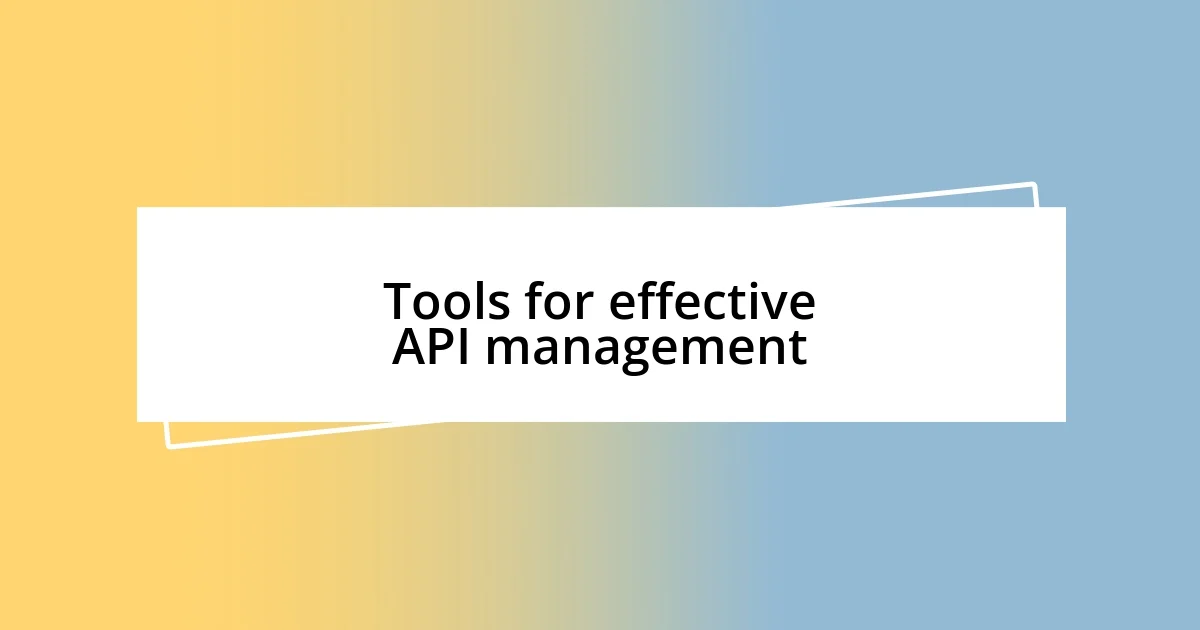Key takeaways:
- APIs serve as essential bridges between software applications, simplifying complex processes and fostering innovation by allowing developers to build on existing platforms.
- Best practices for API integration include thorough documentation, robust error handling, versioning, rate limiting, and extensive testing to ensure seamless implementation.
- Emerging trends in API development focus on low-code platforms, microservices architecture for agility, and the heightened necessity of embedding security within the API lifecycle.

Understanding what APIs are
APIs, or Application Programming Interfaces, are like the bridges that allow different software applications to communicate with one another. I remember my first encounter with an API while working on a project to integrate weather data into my app. At that moment, I realized how powerful these interfaces can be—they enabled me to access real-time information without needing to reinvent the wheel.
Think of APIs as the restaurant menus for developers. Just as a menu provides a list of dishes you can order, an API outlines the commands and responses available to a programmer. Have you ever felt overwhelmed by the sheer amount of data or functionality out there? That’s where APIs come into play—they simplify complex processes, allowing us to tap into existing services with just a few lines of code.
What’s fascinating to me is how APIs enable innovation by allowing developers to build on top of existing platforms. For instance, when I integrated a payment processing API into my application, it revolutionized the way I thought about transactions. Instead of creating my own payment system from scratch, I could focus on enhancing the user experience, showcasing how APIs can foster creativity and efficiency in development.

Best practices for API integration
When integrating APIs, maintaining clear documentation is crucial. It’s like having a roadmap when you’re exploring uncharted territory. In one of my projects, I spent hours fumbling through ambiguous API instructions. I wish I had realized earlier that thorough documentation can save time and prevent frustration. Plus, it can be a lifeline when collaborating with other developers or troubleshooting issues.
Here are some best practices to consider for seamless API integration:
- Read the Documentation Thoroughly: Familiarize yourself with the API’s capabilities and limitations.
- Error Handling: Implement robust error handling to gracefully manage failed requests.
- Versioning: Use versioning to prevent breaking changes that can disrupt your integration.
- Rate Limiting: Respect the API’s rate limits to avoid throttling and ensure fair usage.
- Testing: Conduct extensive testing in a sandbox environment before going live, just to be sure everything runs smoothly.
Understanding these practices has transformed my approach to API integration. Early in my coding journey, I overlooked these details, which led to headaches later on. Nowadays, a structured integration process feels like a well-choreographed dance, allowing for creativity while minimizing disruptions.

Tools for effective API management
Tools for effective API management are essential for streamlining workflows and optimizing performance. In my experience, implementing an API management tool can significantly reduce the chaos often associated with multiple APIs. For instance, I once used a platform that centralized all my API interactions, and it felt like finally having all my groceries in one basket instead of scattered across various stores. This organization brought clarity and efficiency to my work.
Another critical aspect I’ve found is the ability to monitor API performance. Having real-time insights into how an API is functioning allows me to address issues proactively. I recall a time when I neglected to check the health of an API I was using; it led to unexpected downtime in my application. By utilizing monitoring tools, I now catch potential problems before they escalate, ensuring a smoother user experience.
Lastly, consider the documentation features provided by many API management tools. I was once involved in a project where the lack of proper documentation led to confusion among my team. Today, when I can easily generate and maintain updated documentation directly from the management tool, it feels like a weight has lifted off my shoulders. It fosters better collaboration and makes onboarding new team members much easier.
| API Management Tool | Features |
|---|---|
| Postman | Collaboration, Testing, Monitoring |
| Swagger | API Documentation, Design, Client Generation |
| Kong | Performance Monitoring, Security Plugins, Rate Limiting |
| Apigee | Analytics, Debugging, API Gateway |

Future trends in API development
Emerging trends in API development are quite fascinating. One trend that catches my eye is the rise of low-code and no-code platforms. I remember when I first dabbled in these tools; the feeling was liberating. Suddenly, building our applications didn’t require extensive coding skills. Isn’t it exciting to think about how many more people will be able to innovate with APIs in the future, effortlessly creating solutions that were once only accessible to seasoned developers?
Moreover, the push for microservices architecture also stands out. During a collaborative project, I experienced firsthand the advantages of breaking down a monolithic application into smaller, independent services. Each microservice could be developed and deployed separately, which made our workflows much more agile. Don’t you think this flexibility allows for better scaling and faster updates? It’s an approach that not only enhances performance but also promotes innovation by enabling teams to experiment without the cumbersome overhead.
Lastly, the growing importance of API security cannot be overstated. I once worked on an application that faced a security breach due to overlooked vulnerabilities in our API. The anxiety and stress from that experience were profound, driving home the message that as APIs evolve, so must our strategies to protect them. We’re entering an era where embedding security measures directly into the API lifecycle will be essential. How can we create robust solutions if we don’t prioritize security at every stage? It’s a critical point that calls for serious attention as API usage continues to skyrocket.














